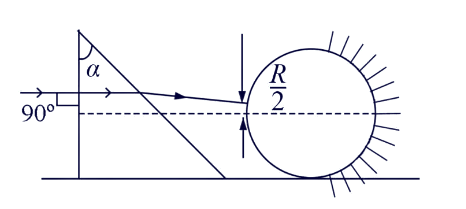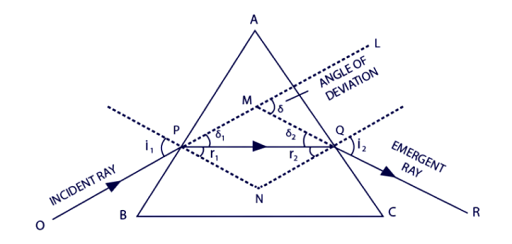
A ray in incident normally on a right-angle prism whose refractive index is √3 and prism angle α=30°. After crossing the prism, the ray passes through a glass sphere. It strikes the glass sphere of the same refractive index at a distance $\dfrac{R}{\sqrt{3}}$ from the principal axis, as shown in the figure. The net angle of deviation of the incident ray is ?

Answer
219.3k+ views
Hint: In this question we will use the concept of deviation in the path of a ray due to refraction while travelling from a denser to a rarer medium and vice versa. We will also be using the properties of reflection from a polished surface.
Complete step by step solution:
The incident ray is parallel strikes normally on a right-angle prism. Therefore, there will be no deviation on the first surface and the ray will pass and hit the second surface of the prism. At the second surface, the ray is travelling from a denser medium to a rarer medium.

For any given triangle,
By geometry, $r_1+r_2$=angle of the triangle
In this question, $r_1$=0°, $r_2$= α=30°.
The relation between i, $r_1$ and μ (refractive index) is:
\[\mu =\dfrac{\sin (i)}{\sin (r)}\]
\[\Rightarrow \sqrt{3}=\]$\dfrac{\sin (i)}{\sin ({{30}^{\circ }})}$
Angle of emergence =60°
We know, angle of the triangle + deviation = i+e
Deviation = 0° + 60° - 30° = 30°
Now, the emergent ray hits the sphere at $\dfrac{R}{\sqrt{3}}$ distance from the principal axis. Making a triangle by dropping a perpendicular at the principal axis from the point where emergent ray hits the sphere. By geometry, we will get the angle opposite the side with height $\dfrac{R}{\sqrt{3}}$ = 30°. Therefore,
$\tan ({{30}^{\circ }})=\dfrac{\dfrac{R}{\sqrt{3}}}{base} \\ $
$\Rightarrow \dfrac{1}{\sqrt{3}}=\dfrac{R}{\sqrt{3}\times base} \\ $
$\Rightarrow base=R$
Since the value of the base is equal to radius, it implies that the ray was incident normally on the sphere surface and it passes through the centre of curvature of the sphere. Now, the ray passing through the centre of curvature of the sphere will hit the polished surface of the sphere normally. Hence, the ray will take a 180° turn and retrace its whole path.
Therefore, the net angle of deviation of the incident ray is 180°.
Note: On a polished surface, if the angle with normal is 0°, the ray will retrace its previous path. If an incident ray strikes normally on a right-angle prism, there will be no deviation on the surface and the ray will pass undeviated. A ray travelling from a denser medium to a rarer medium will bend away from the normal and not towards it.
Complete step by step solution:
The incident ray is parallel strikes normally on a right-angle prism. Therefore, there will be no deviation on the first surface and the ray will pass and hit the second surface of the prism. At the second surface, the ray is travelling from a denser medium to a rarer medium.

For any given triangle,
By geometry, $r_1+r_2$=angle of the triangle
In this question, $r_1$=0°, $r_2$= α=30°.
The relation between i, $r_1$ and μ (refractive index) is:
\[\mu =\dfrac{\sin (i)}{\sin (r)}\]
\[\Rightarrow \sqrt{3}=\]$\dfrac{\sin (i)}{\sin ({{30}^{\circ }})}$
Angle of emergence =60°
We know, angle of the triangle + deviation = i+e
Deviation = 0° + 60° - 30° = 30°
Now, the emergent ray hits the sphere at $\dfrac{R}{\sqrt{3}}$ distance from the principal axis. Making a triangle by dropping a perpendicular at the principal axis from the point where emergent ray hits the sphere. By geometry, we will get the angle opposite the side with height $\dfrac{R}{\sqrt{3}}$ = 30°. Therefore,
$\tan ({{30}^{\circ }})=\dfrac{\dfrac{R}{\sqrt{3}}}{base} \\ $
$\Rightarrow \dfrac{1}{\sqrt{3}}=\dfrac{R}{\sqrt{3}\times base} \\ $
$\Rightarrow base=R$
Since the value of the base is equal to radius, it implies that the ray was incident normally on the sphere surface and it passes through the centre of curvature of the sphere. Now, the ray passing through the centre of curvature of the sphere will hit the polished surface of the sphere normally. Hence, the ray will take a 180° turn and retrace its whole path.
Therefore, the net angle of deviation of the incident ray is 180°.
Note: On a polished surface, if the angle with normal is 0°, the ray will retrace its previous path. If an incident ray strikes normally on a right-angle prism, there will be no deviation on the surface and the ray will pass undeviated. A ray travelling from a denser medium to a rarer medium will bend away from the normal and not towards it.
Recently Updated Pages
JEE Main 2023 (January 31 Morning Shift) Chemistry Question Paper with Solutions [PDF]

JEE Main 2026 Session 1 Correction Window Started: Check Dates, Edit Link & Fees

Complex Numbers Explained: Basics, Formulas & Examples

Electrostatic Potential and Capacitance Explained

Balancing of Redox Reactions - Important Concepts and Tips for JEE

JEE Main 2023 (January 31st Shift 1) Physics Question Paper with Answer Key

Trending doubts
JEE Main 2026: Application Form Open, Exam Dates, Syllabus, Eligibility & Question Papers

Understanding Uniform Acceleration in Physics

Derivation of Equation of Trajectory Explained for Students

Hybridisation in Chemistry – Concept, Types & Applications

Understanding the Angle of Deviation in a Prism

Understanding Collisions: Types and Examples for Students

Other Pages
JEE Advanced Marks vs Ranks 2025: Understanding Category-wise Qualifying Marks and Previous Year Cut-offs

Understanding Atomic Structure for Beginners

How to Convert a Galvanometer into an Ammeter or Voltmeter

Understanding Centrifugal Force in Physics

JEE Main Marking Scheme 2026- Paper-Wise Marks Distribution and Negative Marking Details

Degree of Dissociation: Meaning, Formula, Calculation & Uses




